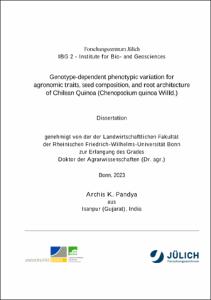Pandya, Archis K.: Genotype-dependent phenotypic variation for agronomic traits, seed composition, and root architecture of Chilean Quinoa (Chenopodium quinoa Willd.). - Bonn, 2023. - Dissertation, Rheinische Friedrich-Wilhelms-Universität Bonn.
Online-Ausgabe in bonndoc: https://nbn-resolving.org/urn:nbn:de:hbz:5-73261
Online-Ausgabe in bonndoc: https://nbn-resolving.org/urn:nbn:de:hbz:5-73261
@phdthesis{handle:20.500.11811/11144,
urn: https://nbn-resolving.org/urn:nbn:de:hbz:5-73261,
author = {{Archis K. Pandya}},
title = {Genotype-dependent phenotypic variation for agronomic traits, seed composition, and root architecture of Chilean Quinoa (Chenopodium quinoa Willd.)},
school = {Rheinische Friedrich-Wilhelms-Universität Bonn},
year = 2023,
month = nov,
note = {Today, climate change is one of the biggest challenges facing agriculture practices, and it has significant implications for the sustainable provision of nutritious food in sufficient amounts. To meet such challenges, there is a need for cultivars that have high yields and desirable agronomic characteristics as well as the ability to use resources more efficiently. In recent years, quinoa (Chenopodium quinoa Willd.), a pseudocereal crop has become increasingly popular due to its high nutritional value and adaptability to a range of harsh environmental conditions such as drought, frost, and high salinity making a promising alternative crop for cereals. Understanding the genotype-dependent phenotypic mechanism and existing variation of important agronomic traits is crucial for the development of modern quinoa breeding. The present research work was designed to characterize the existing genotype-dependent phenotypic variation of Chilean quinoa germplasm using standardized above- and below-ground related agro-morphological descriptors. The combined analysis of uni- and multivariate analysis showed a good wide significant variation (p < 0.05) among the evaluated C. quinoa accessions for agro-morphological and root-related descriptors, and allowed a deeper understanding of the interrelationship within genotypes for evaluated traits. Also, the Principle Component Analysis (PCA) and cluster analysis, revealed the appearance of some candidate genotypes that were distinctly grouped and located from the average dispersion of entire studied accessions. These accessions were associated with early precocity, high seed yield, and vigorous rooting pattern. Other than that, the content of antinutrient triterpenoid saponins and bioactive phenolic components were assessed using GC-MS/LC-MS for the available C. quinoa germplasm. The variation in the content and type of these metabolites in quinoa genetic resources were considered significant. The relative content for the saponins and phenolics were in ranged between 0.22 mg/g to 15.04 mg/g and 35.51 mg/100 g to 93.23 mg/100 g of seed dry weight, respectively. Our study found significant variability concerning agro-morphological descriptors, secondary metabolites content, and rooting pattern in C. quinoa, which can contribute to the value of genetic resources for the identification of ideal genotypes that might be used in current and future C. quinoa breeding programs.},
url = {https://hdl.handle.net/20.500.11811/11144}
}
urn: https://nbn-resolving.org/urn:nbn:de:hbz:5-73261,
author = {{Archis K. Pandya}},
title = {Genotype-dependent phenotypic variation for agronomic traits, seed composition, and root architecture of Chilean Quinoa (Chenopodium quinoa Willd.)},
school = {Rheinische Friedrich-Wilhelms-Universität Bonn},
year = 2023,
month = nov,
note = {Today, climate change is one of the biggest challenges facing agriculture practices, and it has significant implications for the sustainable provision of nutritious food in sufficient amounts. To meet such challenges, there is a need for cultivars that have high yields and desirable agronomic characteristics as well as the ability to use resources more efficiently. In recent years, quinoa (Chenopodium quinoa Willd.), a pseudocereal crop has become increasingly popular due to its high nutritional value and adaptability to a range of harsh environmental conditions such as drought, frost, and high salinity making a promising alternative crop for cereals. Understanding the genotype-dependent phenotypic mechanism and existing variation of important agronomic traits is crucial for the development of modern quinoa breeding. The present research work was designed to characterize the existing genotype-dependent phenotypic variation of Chilean quinoa germplasm using standardized above- and below-ground related agro-morphological descriptors. The combined analysis of uni- and multivariate analysis showed a good wide significant variation (p < 0.05) among the evaluated C. quinoa accessions for agro-morphological and root-related descriptors, and allowed a deeper understanding of the interrelationship within genotypes for evaluated traits. Also, the Principle Component Analysis (PCA) and cluster analysis, revealed the appearance of some candidate genotypes that were distinctly grouped and located from the average dispersion of entire studied accessions. These accessions were associated with early precocity, high seed yield, and vigorous rooting pattern. Other than that, the content of antinutrient triterpenoid saponins and bioactive phenolic components were assessed using GC-MS/LC-MS for the available C. quinoa germplasm. The variation in the content and type of these metabolites in quinoa genetic resources were considered significant. The relative content for the saponins and phenolics were in ranged between 0.22 mg/g to 15.04 mg/g and 35.51 mg/100 g to 93.23 mg/100 g of seed dry weight, respectively. Our study found significant variability concerning agro-morphological descriptors, secondary metabolites content, and rooting pattern in C. quinoa, which can contribute to the value of genetic resources for the identification of ideal genotypes that might be used in current and future C. quinoa breeding programs.},
url = {https://hdl.handle.net/20.500.11811/11144}
}






